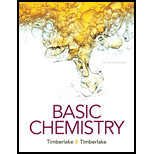
Concept explainers
(a)
Interpretation:
To state the reason that why does an enzyme speed up the reaction.
Concept Introduction:
An enzyme is also a protein which has the capability to bind with the substrate (reactant molecule) by recognizing it .Enzymes have a unique three-dimensional shape which helps them in binding to the substrate. The size of an enzyme is typically larger than that of the substrate , and it contains a region known as active site within its structure .This active site is responsible for binding the substrate and thus catalyzing the given reaction.
(b)
Interpretation:
To state that what happens to the enzyme after the product has been formed.
Concept Introduction:
An enzyme is also a protein which has the capability to bind with the substrate (reactant molecule) by recognizing it .Enzymes have a unique three-dimensional shape which helps them in binding to the substrate. The size of an enzyme is typically larger than that of the substrate, and it contains a region known as active site within its structure .This active site is responsible for binding the substrate and thus catalyzing the given reaction.
Want to see the full answer?
Check out a sample textbook solution
Chapter 18 Solutions
Basic Chemistry (5th Edition)
 ChemistryChemistryISBN:9781305957404Author:Steven S. Zumdahl, Susan A. Zumdahl, Donald J. DeCostePublisher:Cengage Learning
ChemistryChemistryISBN:9781305957404Author:Steven S. Zumdahl, Susan A. Zumdahl, Donald J. DeCostePublisher:Cengage Learning ChemistryChemistryISBN:9781259911156Author:Raymond Chang Dr., Jason Overby ProfessorPublisher:McGraw-Hill Education
ChemistryChemistryISBN:9781259911156Author:Raymond Chang Dr., Jason Overby ProfessorPublisher:McGraw-Hill Education Principles of Instrumental AnalysisChemistryISBN:9781305577213Author:Douglas A. Skoog, F. James Holler, Stanley R. CrouchPublisher:Cengage Learning
Principles of Instrumental AnalysisChemistryISBN:9781305577213Author:Douglas A. Skoog, F. James Holler, Stanley R. CrouchPublisher:Cengage Learning Organic ChemistryChemistryISBN:9780078021558Author:Janice Gorzynski Smith Dr.Publisher:McGraw-Hill Education
Organic ChemistryChemistryISBN:9780078021558Author:Janice Gorzynski Smith Dr.Publisher:McGraw-Hill Education Chemistry: Principles and ReactionsChemistryISBN:9781305079373Author:William L. Masterton, Cecile N. HurleyPublisher:Cengage Learning
Chemistry: Principles and ReactionsChemistryISBN:9781305079373Author:William L. Masterton, Cecile N. HurleyPublisher:Cengage Learning Elementary Principles of Chemical Processes, Bind...ChemistryISBN:9781118431221Author:Richard M. Felder, Ronald W. Rousseau, Lisa G. BullardPublisher:WILEY
Elementary Principles of Chemical Processes, Bind...ChemistryISBN:9781118431221Author:Richard M. Felder, Ronald W. Rousseau, Lisa G. BullardPublisher:WILEY





